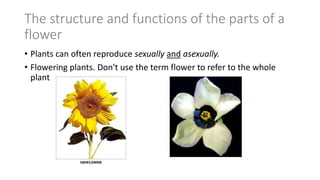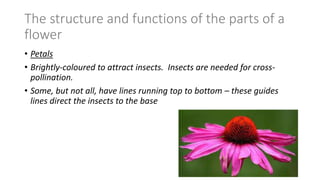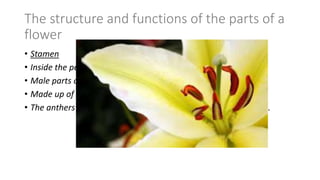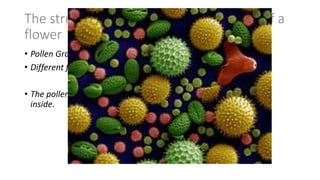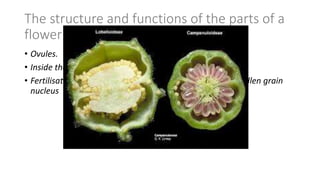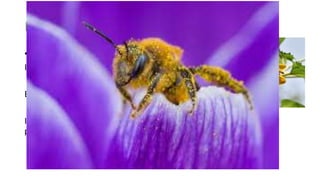Rep in plants 2
- 2. The structure and functions of the parts of a flower • Plants can often reproduce sexually and asexually. • Flowering plants. Don't use the term flower to refer to the whole plant
- 3. The structure and functions of the parts of a flower • Flower • Function: to make gametes and ensure fertilisation. • Flowering plants often rely on insect-pollination (instead of wind- pollination). • Made up of: sepal (green leaf-like structures that enclose the petals); petals (often brightly coloured); carpel (female); stamen (male).
- 4. The structure and functions of the parts of a flower • Sepal • Modified green leaves at the base of the flower. They protect the developing flower
- 5. The structure and functions of the parts of a flower • Petals • Brightly-coloured to attract insects. Insects are needed for cross- pollination. • Some, but not all, have lines running top to bottom – these guides lines direct the insects to the base
- 6. The structure and functions of the parts of a flower • Nectary • Gland that makes a sugary liquid, nectar. Which insects feed on.
- 7. The structure and functions of the parts of a flower • Carpels • Found in the centre. • Includes the ovary, which contains the ovules (female gametes produced) • At the top of the ovary is the style, with a sticky stigma on the end. The stigma catches pollen grains for fertillisation.
- 8. The structure and functions of the parts of a flower • Stamen • Inside the petals. • Male parts of the flower • Made up of a long filament with an anther at the top. • The anthers contain pollen grains, which contain male gametes.
- 9. The structure and functions of the parts of a flower • Flower = produces both male and female gametes • Sepal = protects the developing flower • Petals = attract insects • Nectary = gland producing nectar • Carpel = female part • Ovary = contains the ovule, female gamete production • Stamen = male part • Filament = has anther at the top, contains pollen grains with male gametes
- 10. The structure and functions of the parts of a flower • Pollen Grains. • Pollen sacs in the anther contain developing pollen grains. The pollen grains are produced my meiosis. • When the anther is mature the sacs split open to release the pollen grains
- 11. The structure and functions of the parts of a flower • Pollen Grains. • Different flowers produce different shaped/sized pollen grains. • The pollen grains have a hard coat, to protect the male gametes inside.
- 12. The structure and functions of the parts of a flower • Ovules. • Inside the ovules, female gametes are formed by meiosis. • Fertilisation occurs when an ovule nucleus fuses with a pollen grain nucleus
- 13. Pollination and fertilisation in flowers • Pollination • "The transfer of pollen from the male part to the female part." • The male gametes must travel to the female gametes.
- 14. Pollination and fertilisation in flowers • Insect-pollination Insects are attracted to the flower Brightly-coloured petals and sweet scent (nectar) Insects follow the guideline down the petal to the nectary, brushing past anthers (coating itself in pollen) along the way.
- 15. Pollination and fertilisation in flowers • Insect-pollination The same insect then travels to another plant in search of more nectar Pollen grain from the first flower attach to the sticky stigma of the next flower. If the two flowers are the same species, fertilisation can happen.
- 16. Pollination and fertilisation in flowers Experiment to test: "Bees visit yellow flowers more often than flowers of other colours" Method? Variable to control? How can we record results? Does this experiment show that bees see colour or are colour-blind?
- 17. Pollination and fertilisation in flowers • Self-pollination / Cross-pollination • If a flower's stigma receives pollen grains from it's own anther (or from another flower on the same plant) = self-pollination.
- 18. Pollination and fertilisation in flowers • Self-pollination / Cross-pollination • If a flower's stigma receives pollen grains from a different flowering plant = cross-pollination. Must be of the same species for fertilisation to occur
- 19. Pollination and fertilisation in flowers • Wind-fertilisation • Instead of insects carrying pollen grains from one flower to another, wind blows the pollen.
- 20. Pollination and fertilisation in flowers Insect Wind Petals Large/brightly coloured Small/absent Scent Strong No scent Nectaries Present Absent Anthers Inside flower, ensuring insect passes-by Outside flower Stigma Inside flower, ensuring insect passes-by Outside flower Pollen grains Spiky to attach to insect Smooth to blow in the wind Quantities Large, as some will be delivered to wrong kind of flowers Very large, as most will be lost and blown away

